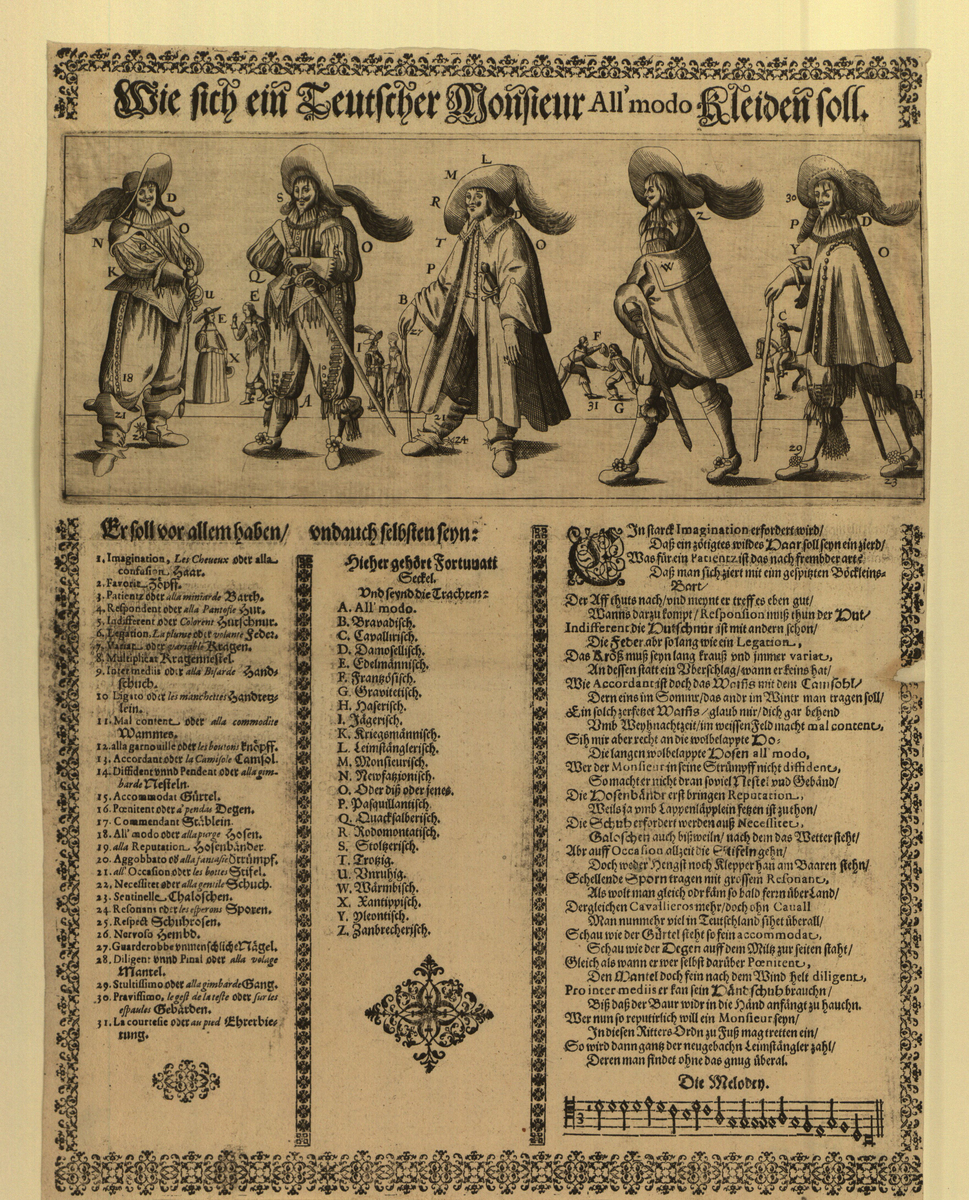How a German Gentleman Should Dress all’modo (i.e. fashionably) (c. 1630)
Abstract
France’s political supremacy in the 17th century also found its expression in cultural hegemony, which in turn led to patriotic counter-reactions in many German lands. These culminated, among other things, in the so-called “Alamode controversy” [Alamode-Streit], a debate about appropriate “patriotic” clothing, during whose course various pamphlets were disseminated. These pamphlets criticized and ridiculed French and courtly fashions—and the imitation of those styles by Germans. Different styles of national dress were set off against each other, and the imitation of “foreign” fashions was criticized. The following humorous broadsheet from the time of the Alamode-Streit describes what a fashionable German gentleman was supposed to wear and what his outfit needed to project.
Source
How a German Gentleman Should Dress all’modo [fashionably]
He should above have all of these, and also himself be:
1. Imagination, les cheveux, or alla confusion, hair.
Fortunatus’s purse belongs here
A. All’modo.
A good imagination is necessary
The melody.
Translation: Kathleen Dell’Orto

2. Favorit braid.
3. Patientz [patience], or alla miniarde beard.
4. Respondent or alle Pantofle [pantofle-like] hat.
5. Indifferent or colorent [colored] hatstring
6. Legation [legateship], La plume or volante [flying] feather.
7. Variat or variable collar.
8. Multiplicat [multiple] collar tie.
9. Intermediis [intermediary] or alla Bisarde gloves.
10. Ligato or les manchettes sleeve cuffs.
11. Mal content or alla commodite [comfortable] vest.
12. Alla garnouille or les boutons buttons.
13. Accordant [matching] or la Camisole [jacket] jacket.
14. Diffident and pendent or alla gimbarde] laces.
15. Acommodat [ensemble] belt.
16. Poenitent [penitent] or a’pendas dagger.
17. Commendant walking stick.
18. All’modo [fashionable] or allapurge [for purging] pants.
19. Alla Reputation knee bands.
20. Aggobbato [crookbacked] or alla fantasie stockings.
21. All’Occasion les bottes boots.
22. Necessitet [necessity] or alla gentile [fine] shoes.
23. Sentinelle [guard] galoshes.
24. Resonans [resonance] or les esperons [hopes] spurs.
25. Respect shoe roses.
26. Nervolo shirt.
27. Guarderobbe [wardrobe] inhuman nails.
28. Diligent and pinal or alla volage [fickle] coat.
29. Stultissimo [very stupid] or alla gimbarde [by vehicle] gait.
30. Pravissimo [very depraved], le gest de la teste or sur les espaules [head or shoulder gesture] gestures.
31. La courtesie or au pied [on foot] deference.
And his outfits are:
B. Bravadish.
C. Cavalierish.
D. Damsel-ish.
E. Esquir-ish.
F. French-ish.
G. Gravitas-ish.
H. Hare-ish.
J. Jostling-hunter-ish.
K. Knowing-soldier-ish.
L. Love-bungler-ish.
M. Monsieur-ish.
N. New-fashion-ish.
O. Or this and that.
P. Pasquinader-ish.
Q. Quackish.
R. Rodomontish.
S. Struterish.
T. Truculent.
U. Unrestful.
W. Warm-ish.
X. Xantipp-ish.
Y. Yleont-ish.
Z. Zealous-tooth-breaker-ish.
For filthy, thin hair to be an ornament.
What kind of patience of a foreign kind is it
That the person adorns himself with a pointed little goat’s beard.
A monkey would imitate it, and think he really got it right.
When it comes to that, the hat must make the response.
The hat string is indifferent, with other things;
But the feather is as long as a legateship;
The ruff must be long, sharply pleated, and always varied,
Instead of that a collar, if he has none.
The vest matches the jacket,
The one should be worn in summer, the other in winter.
Such a torn-up vest, believe me, very handsome on you
At Christmas time, in the white field, will make you dissatisfied.
But look at me, correct and the well-patched pants
The long well-patched fashionable pants
If the monsieur were not diffident in his stockings,
He would not put so many laces and ribbons on them.
The knee bands really give a reputation,
Because it is a matter of putting on little patchy patches.
The shoes are required out of necessity,
Galoshes at times as well, depending on the weather.
But boots are always good for any occasion.
Yet neither a stallion nor a nag will quietly stand before a bear,
So jangling spurs are worn with great resonance,
As if one wanted to ride right away or rode far across the land.
More of the same cavalieros, but without a caval [horse],
Are now seen often everywhere in Germany.
Look how the belt looks good on your ensemble!
Look how the dagger lies to the side of your spleen!
Just as if it were itself penitent.
The fine coat holds up to the wind diligent[ly]
Through an intermediary he can use his gloves,
Until the peasant starts to breathe in his hands again.
Anyone who wants to be a monsieur by reputation,
May arrive in this knightly order on foot.
Then the number of newly baked love-bunglers will be complete;
Enough of them are to be found everywhere without that.
Source: Wie sich ein Teutscher Monsieur All’modo Kleiden soll, c. 1630. Copperplate engraving. Signature: H61/EINBLATTDRUCK.A-X 11, Manuscript Department, University Library Erlangen-Nuremberg. Reprinted in Wolfgang Harms, ed., Deutsche illustrierte Flugblätter des 16. und 17. Jahrhunderts. Band I (Wolfenbüttel Teil 1). Tübingen, 1985, p. 259.
Manuscript Department, University Library Erlangen-Nuremberg
Further Reading
Ulinka Rublack, Dressing Up. Cultural Identity in Renaissance Europe. New York: Oxford University Press, 2010.
Claudia Ulbrich and Richard Wittmann, eds., Fashioning the Self in Transcultural Settings: The Uses and Significance of Dress in Self-Narratives. (Istanbuler Studien und Texte 17) Würzburg, 2015.